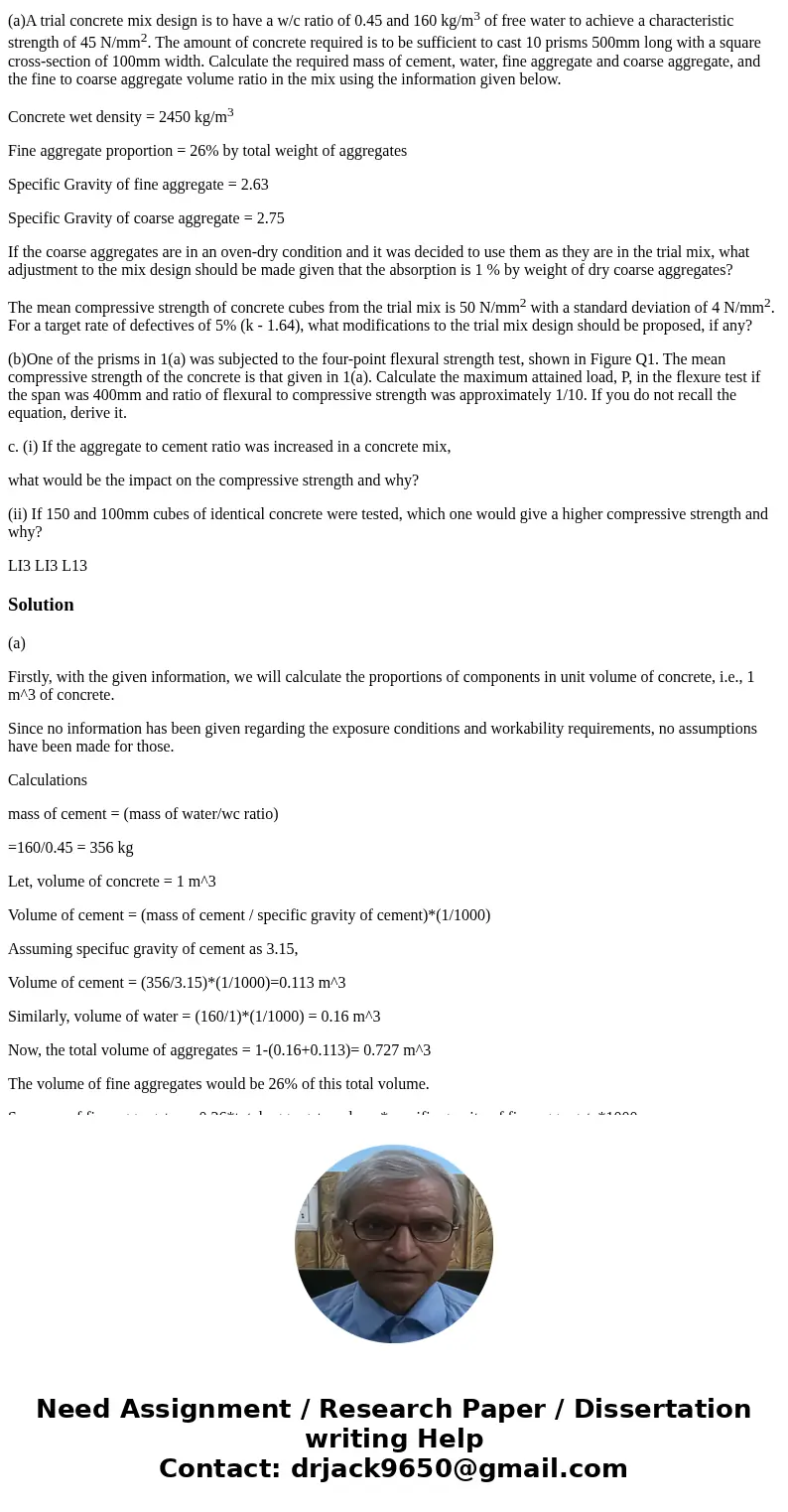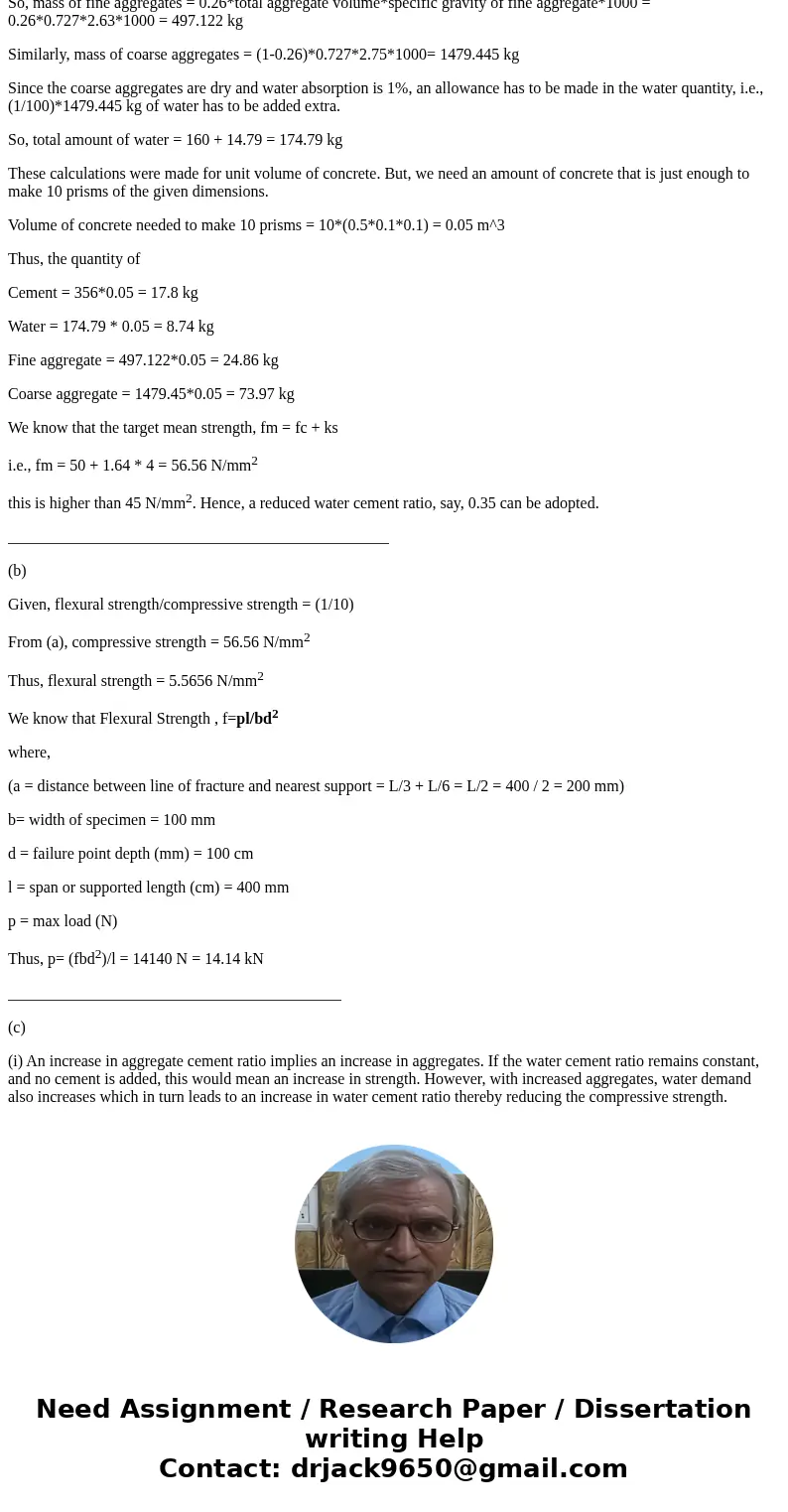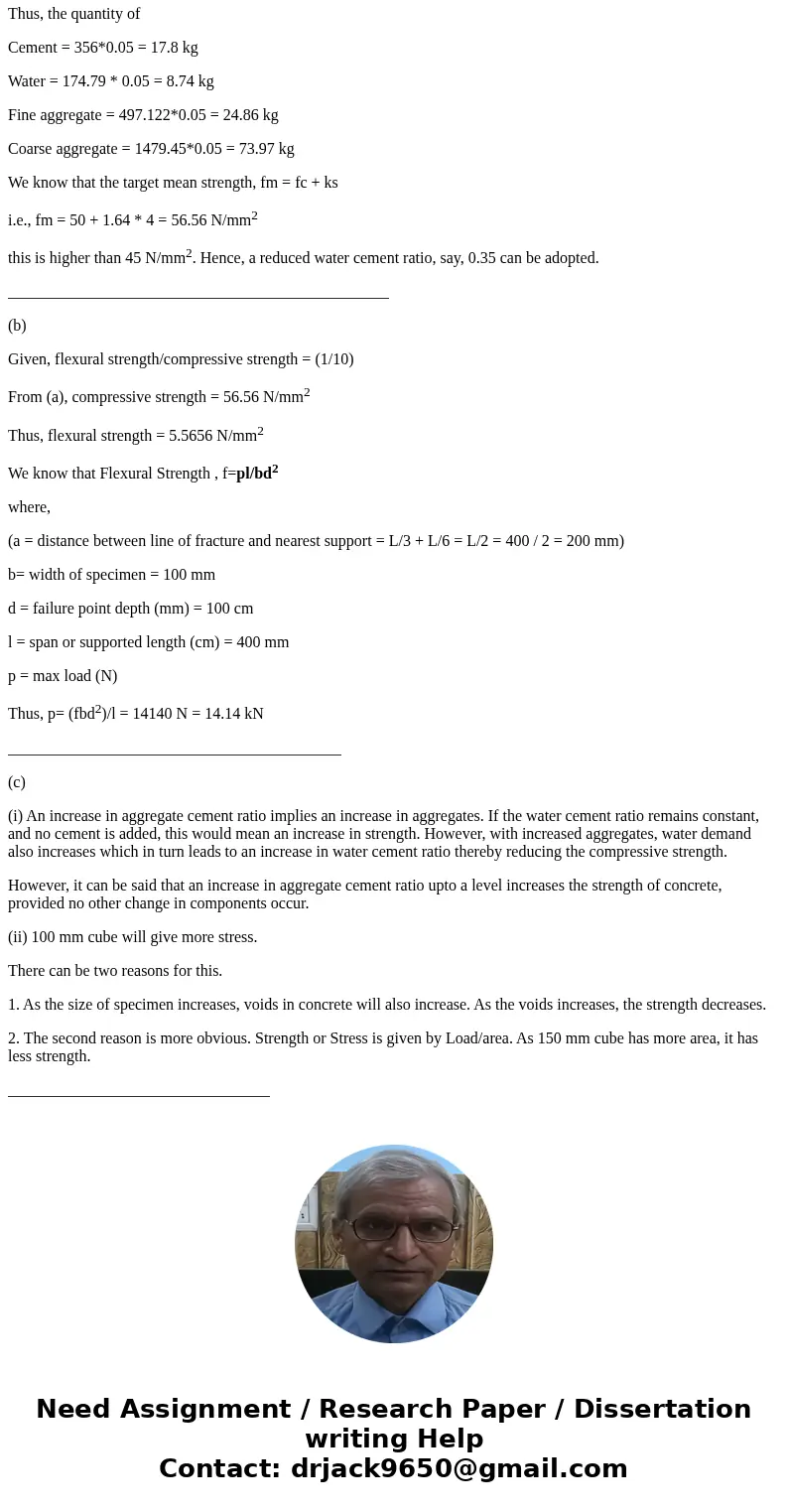aA trial concrete mix design is to have a wc ratio of 045 an
(a)A trial concrete mix design is to have a w/c ratio of 0.45 and 160 kg/m3 of free water to achieve a characteristic strength of 45 N/mm2. The amount of concrete required is to be sufficient to cast 10 prisms 500mm long with a square cross-section of 100mm width. Calculate the required mass of cement, water, fine aggregate and coarse aggregate, and the fine to coarse aggregate volume ratio in the mix using the information given below.
Concrete wet density = 2450 kg/m3
Fine aggregate proportion = 26% by total weight of aggregates
Specific Gravity of fine aggregate = 2.63
Specific Gravity of coarse aggregate = 2.75
If the coarse aggregates are in an oven-dry condition and it was decided to use them as they are in the trial mix, what adjustment to the mix design should be made given that the absorption is 1 % by weight of dry coarse aggregates?
The mean compressive strength of concrete cubes from the trial mix is 50 N/mm2 with a standard deviation of 4 N/mm2. For a target rate of defectives of 5% (k - 1.64), what modifications to the trial mix design should be proposed, if any?
(b)One of the prisms in 1(a) was subjected to the four-point flexural strength test, shown in Figure Q1. The mean compressive strength of the concrete is that given in 1(a). Calculate the maximum attained load, P, in the flexure test if the span was 400mm and ratio of flexural to compressive strength was approximately 1/10. If you do not recall the equation, derive it.
c. (i) If the aggregate to cement ratio was increased in a concrete mix,
what would be the impact on the compressive strength and why?
(ii) If 150 and 100mm cubes of identical concrete were tested, which one would give a higher compressive strength and why?
LI3 LI3 L13Solution
(a)
Firstly, with the given information, we will calculate the proportions of components in unit volume of concrete, i.e., 1 m^3 of concrete.
Since no information has been given regarding the exposure conditions and workability requirements, no assumptions have been made for those.
Calculations
mass of cement = (mass of water/wc ratio)
=160/0.45 = 356 kg
Let, volume of concrete = 1 m^3
Volume of cement = (mass of cement / specific gravity of cement)*(1/1000)
Assuming specifuc gravity of cement as 3.15,
Volume of cement = (356/3.15)*(1/1000)=0.113 m^3
Similarly, volume of water = (160/1)*(1/1000) = 0.16 m^3
Now, the total volume of aggregates = 1-(0.16+0.113)= 0.727 m^3
The volume of fine aggregates would be 26% of this total volume.
So, mass of fine aggregates = 0.26*total aggregate volume*specific gravity of fine aggregate*1000 = 0.26*0.727*2.63*1000 = 497.122 kg
Similarly, mass of coarse aggregates = (1-0.26)*0.727*2.75*1000= 1479.445 kg
Since the coarse aggregates are dry and water absorption is 1%, an allowance has to be made in the water quantity, i.e., (1/100)*1479.445 kg of water has to be added extra.
So, total amount of water = 160 + 14.79 = 174.79 kg
These calculations were made for unit volume of concrete. But, we need an amount of concrete that is just enough to make 10 prisms of the given dimensions.
Volume of concrete needed to make 10 prisms = 10*(0.5*0.1*0.1) = 0.05 m^3
Thus, the quantity of
Cement = 356*0.05 = 17.8 kg
Water = 174.79 * 0.05 = 8.74 kg
Fine aggregate = 497.122*0.05 = 24.86 kg
Coarse aggregate = 1479.45*0.05 = 73.97 kg
We know that the target mean strength, fm = fc + ks
i.e., fm = 50 + 1.64 * 4 = 56.56 N/mm2
this is higher than 45 N/mm2. Hence, a reduced water cement ratio, say, 0.35 can be adopted.
________________________________________________
(b)
Given, flexural strength/compressive strength = (1/10)
From (a), compressive strength = 56.56 N/mm2
Thus, flexural strength = 5.5656 N/mm2
We know that Flexural Strength , f=pl/bd2
where,
(a = distance between line of fracture and nearest support = L/3 + L/6 = L/2 = 400 / 2 = 200 mm)
b= width of specimen = 100 mm
d = failure point depth (mm) = 100 cm
l = span or supported length (cm) = 400 mm
p = max load (N)
Thus, p= (fbd2)/l = 14140 N = 14.14 kN
__________________________________________
(c)
(i) An increase in aggregate cement ratio implies an increase in aggregates. If the water cement ratio remains constant, and no cement is added, this would mean an increase in strength. However, with increased aggregates, water demand also increases which in turn leads to an increase in water cement ratio thereby reducing the compressive strength.
However, it can be said that an increase in aggregate cement ratio upto a level increases the strength of concrete, provided no other change in components occur.
(ii) 100 mm cube will give more stress.
There can be two reasons for this.
1. As the size of specimen increases, voids in concrete will also increase. As the voids increases, the strength decreases.
2. The second reason is more obvious. Strength or Stress is given by Load/area. As 150 mm cube has more area, it has less strength.
_________________________________



 Homework Sourse
Homework Sourse